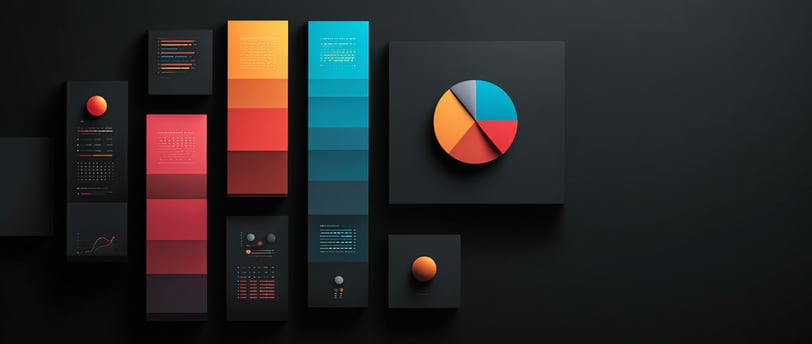The Best Entry-Level Data Courses for Beginners (2025 Guide)
Start your data journey with confidence, this guide highlights the top beginner friendly courses in 2025 to build practical skills and land your first role.
7/4/20256 min read


Not all beginner courses are created equal, and the world of data is fast-moving. The best entry-level programs share a few key traits that make them effective for those just starting:
Beginner-Friendly Explanations: Concepts are introduced with minimal jargon and plenty of real-world examples to help you build confidence early on.
Practical, Hands-On Learning: Theoretical lessons are paired with exercises, mini-projects, or interactive platforms so you can apply what you learn immediately.
Progressive Skill Building: Good courses start with the basics, like spreadsheets, SQL, or Python, and gradually build toward more advanced topics like data visualisation or basic machine learning.
Industry-Relevant Tools: They teach the tools you’ll use on the job (think: Python, SQL, Excel, Power BI, etc.).
Certificates or Credentials: Optional but helpful, especially for job seekers; these courses offer completion certificates you can share on your resume or LinkedIn.
Choosing the right course means looking for one that meets you at your level and gives you the momentum to keep going.
Breaking into data can feel overwhelming; there are hundreds of online platforms, courses and tools out there, and it's difficult to know where to start.
In 2025, the demand for data skills continues to grow across nearly every industry, and the good news is: you don’t need a degree or years of coding to get started. What you do need is the right course that meets you at your level, teaches the tools employers use, and helps you build confidence.
Whether you're aiming to become a data analyst, pivot careers, or explore what working with data is all about, we’ve rounded up the best entry-level data courses available right now, both free and paid.
What Makes a Great Entry-Level Data Course?
All Recommended Courses: Quick Links →
Top Recommended Courses by Focus Area
To help you choose the best starting point, we’ve broken down the most popular entry-level data courses into categories based on the skill or tool they teach. Each one is beginner-friendly, well-reviewed, and updated for 2025.
General Data Fundamentals
Google Data Analytics Certificate (Coursera)
A structured and beginner-friendly program that covers everything from cleaning data in spreadsheets to using SQL and visualising insights in Tableau. Great for total beginners looking to land their first data analyst role.
Time: ~6 months at 10 hours/week
DataCamp: Data Literacy Fundamentals
If you're starting from scratch, this short, interactive course helps you understand what data is, how it's used, and how to think critically with data.
Time: ~2–3 hours
Learn SQL
SQL for Data Analysis (Mode Analytics)
A clean, free, browser-based course ideal for beginners wanting to learn SQL in a real-world analytics context.
Time: Self-paced
DataCamp: Introduction to SQL
A highly visual and interactive way to learn SQL basics for querying databases. No setup required.
Time: ~4 hours
Learn Python for Data
Python for Everybody (University of Michigan, Coursera)
One of the most beginner-friendly introductions to Python, this course takes you from “what is a variable?” to writing programs that manipulate files and web data.
Time: ~4 months (self-paced)
Dataquest: Python for Data Science – Beginner
Project-based and code-focused, this interactive course walks you through Python basics while building small, practical data projects.
Time: Varies by pace
Excel and Spreadsheets
Excel Skills for Data Analytics (Coursera, Macquarie University)
Great for those more comfortable starting in Excel before jumping into code. This course covers formulas, pivot tables, and even some automation.
Time: ~3–4 weeks
Google Sheets Masterclass (Udemy)
Solve Data Analysis Problems, become an Expert: Learn Pivot Tables, QUERY & more.
Time: ~2 weeks
How to Choose the Right Course for Your Goals
All Recommended Platforms: Quick Links →
Not all beginner data courses work for everyone. Aiming to become a data analyst might not suit someone leaning toward data science or engineering. Here's how to pick the course that fits you best:
Define Your Career Goal
Start by identifying which data role you’re aiming for:
Data Analyst: Focus on courses that teach SQL, Excel, Tableau, and basic statistics.
Data Scientist: Prioritise Python, machine learning foundations, and data wrangling.
Data Engineer: Look for beginner Python plus SQL, with pathways into cloud platforms or databases.
ML Engineer: Choose Python-focused courses, especially those that touch on scripting, automation, or AI basics.
AI/Automation Engineer: Choose automation platforms or AI basics, n8n or make.com are great choices.
Knowing your target direction helps you skip distractions and build a tailored foundation.
Consider Your Time Commitment
Be realistic about how much time you can invest:
A few hours a week? Start with micro-courses on platforms like DataCamp or LinkedIn Learning.
Able to commit more consistently? Go for structured certificates like Google Data Analytics or Python for Everybody.
Consistency matters more than intensity when you're starting.
Choose Your Learning Style
Prefer watching and listening? → Video-based platforms like Coursera or YouTube may suit you.
Like hands-on learning? → Interactive platforms like Dataquest and DataCamp are ideal.
Enjoy reading and self-pacing? → Check out written tutorials like W3Schools, Mode Analytics, or SQLBolt.
The best course is one you’ll stick with—choose the format that matches your learning habits.
Check the Cost, and What’s Included
Many platforms offer free tiers or audit options (e.g. Coursera, edX).
Others are subscription-based but include certificates, hands-on projects, and community support.
Don’t underestimate the value of project-based learning and practical feedback, even if it costs a bit more.
Think of your course as an investment in building the skills that’ll pay off fast once you land your first data job.
Starting a new learning journey is exciting, but staying consistent is where most beginners fall off. Here are practical, beginner-friendly strategies to keep you progressing.
Set Micro-Goals Each Week
Break your course into bite-sized milestones:
Complete one module per week
Build your first simple dashboard
Write your first SQL query or Python script
Small wins compound into confidence and momentum.
Create a Learning Schedule
Treat your course like a class. Block out 30–60 minutes at regular intervals during the week (e.g., Mondays, Wednesdays, and Saturdays). Consistency is key for technical subjects.
Practice, Don’t Just Watch
Watching a tutorial is not the same as learning it. Pause videos, replicate code, and challenge yourself with the exercises. Platforms like DataCamp or Dataquest are great because they force you to practice as you go.
Build a Mini Portfolio Early
As soon as you complete a project, whether it’s analysing a dataset, cleaning data, or visualising insights, save it. Host your projects on GitHub or build a Notion page. You’ll have something to show future employers even before your first job.
Join a Community (Even If You’re Shy)
Data learning communities like:
LinkedIn groups or Discord servers
...can help you stay accountable, get unstuck quickly, and meet peers on the same path.
Celebrate Progress, Not Perfection
Every line of code written, every quiz passed, every new term understood...celebrate it. Learning data is a marathon, not a sprint. Progress beats perfection.


Tips to Stay Motivated and Make the Most of Your Course


Final Recommendations & Next Steps
Starting your data journey doesn’t require a degree, years of experience, or fancy equipment; just curiosity, consistency, and the right course. If you’ve made it this far, you already have the motivation you need.
Here’s what to do next:
Pick One Course and Stick With It
Choose based on your learning style and goals. If you prefer interactive, hands-on learning, go for something like DataCamp or Coursera’s Google Data Analytics certificate. If you're looking for a more traditional academic vibe, consider edX’s Harvard Intro to Data Science.
Don’t waste time bouncing between courses; commit to one.
Apply What You Learn Immediately
The best way to learn is to do. As you go through lessons, start building your projects using public datasets (like Kaggle or data.gov). Apply the concepts in your context—whether it’s sports stats, personal finance, or even hobby data.
Start Networking Early
Learning in isolation can be tough. Share your progress online (LinkedIn, GitHub, Twitter), join beginner-friendly communities, and don’t be afraid to ask “basic” questions. Employers love to see learners who take initiative and engage with the field.
Keep the Momentum Going
After your first course, build on it:
Move to intermediate material (machine learning, SQL joins, etc.)
Start a portfolio
Prepare for internships or freelance gigs
Explore certifications (Google, IBM, AWS)
Your journey into data doesn’t end with a course; it begins there.
Detailed Role Guides: Quick Links →
